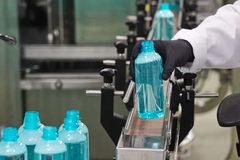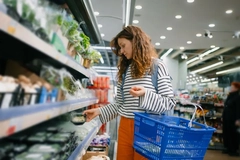Student invents edible noodle packaging that dissolves in boiling water

07 Sep 2020 --- UK design student Holly Grounds has created instant noodle packaging manufactured from an edible and dissolvable potato starch-based film. The solution eliminates the need for single-use plastic sachets. Moreover, spices and flavorings are set into the film, which dissolves in contact with boiling water, rehydrating and cooking the noodles with added taste. Grounds is developing the concept toward commercial launch and hopes to attract some of the big names in instant noodles.
“Long days (and nights) as a product design student made me more familiar with convenience foods than ever before. I was shocked at the environmental impact – particularly, in the world of instant ramen noodles, there is often more plastic than noodles,” Grounds tells PackagingInsights.
“For a meal that can be cooked and eaten in under ten minutes, the plastic packaging can take decades to decompose – typically, 80 years plus. The plastic film is notoriously problematic to recycle since most council’s kerbside recycling schemes currently reject it,” she adds.
 Spices and flavorings are set into the film and dissolve in contact with boiling water.With interest in environmentally sustainable material innovation, Grounds looked to bio-based materials for a solution. She experimented with various bio-based films before settling on a potato starch-based film that is tasteless, heat-sealable and dissolves in contact with boiling water.
Spices and flavorings are set into the film and dissolve in contact with boiling water.With interest in environmentally sustainable material innovation, Grounds looked to bio-based materials for a solution. She experimented with various bio-based films before settling on a potato starch-based film that is tasteless, heat-sealable and dissolves in contact with boiling water.
“When manufacturing the starch-based film, I encountered various challenges and many (mostly unsuccessful) outcomes. During the setting process, the film often cracked, was too flimsy or too brittle, due to factors such as air humidity. Eventually, a winning combination for the environment and ingredients was found.”
Convenient cooking
Next, Grounds explored how to incorporate dried food and spices into the film, finding that smaller spices and dried herbs set most successfully. She then carried out speed cooking tests between the dissolvable noodle pack and an off-the-shelf ramen noodle pack. Reassuringly, the dissolvable method was much faster, eliminating the need to open fiddly sachets.
For hygiene and to further dispense with unnecessary plastic, the dissolvable noodle parcels are packaged in a wax-coated paper outer. The solution’s shelf life performance is yet to be tested, but the dehydrated noodles, dried herbs and spices last significantly longer than fresh ingredients, Grounds says. The potato starch-based film is tasteless, heat-sealable and dissolves in contact with boiling water.
The potato starch-based film is tasteless, heat-sealable and dissolves in contact with boiling water.
Consumer acceptance
Consumer reviews have been mostly positive as people understand the importance of finding a more sustainable solution to the single-plastic problem caused by instant noodles, Grounds shares.
“Over 100 billion instant noodle units are eaten globally per year – that's a lot of plastic. I’ve had some extremely positive messages about the project, giving me hope that consumers will be on board.”
“Others have been skeptical about the concept, as it is a new way of cooking and consuming food. However, I believe that to fight this plastic pollution emergency, we need to be more open-minded about future innovations. Sometimes what seems to be the craziest ideas make the most impact,” Grounds affirms.
Extending applications
The project development will continue by exploring the opportunities other dehydrated ready meals present. Innovation of this sort would maintain the next generation’s need for convenience in the kitchen while creating a meaningful contribution in the fight against single-use plastic pollution, Grounds says. The designer hopes to catch the eye of big players in instant noodles.
The designer hopes to catch the eye of big players in instant noodles.
“This test redefined what we deem to be an instant meal. I aim to develop the concept and bring it to market in the future. With the right backing, I believe this innovation can make a real difference. I hope some of the big names in instant noodles recognize the innovation, as it's not too late to do something positive for the environment,” she concludes.
In similar projects, UK packaging designer Jayne Cunningham created SEAsoning – an edible, compostable and transparent bioplastic made from potato starch and seaweed. Dutch design graduate Don Kwaning developed a bio-based packaging material from the pith of a cosmopolitan and typically unwanted weed called soft rush. Also, three product designers from NABA University in Milan made cone-shaped fries packaging from discarded potato peels.
The size and value of the global packaging industry are ever-expanding, but the availability of university-level, packaging-specific degrees and courses remains relatively low. PackagingInsights explored whether the discrepancy between the growing importance of packaging and the availability of specialized packaging education needs to change.
By Joshua Poole











